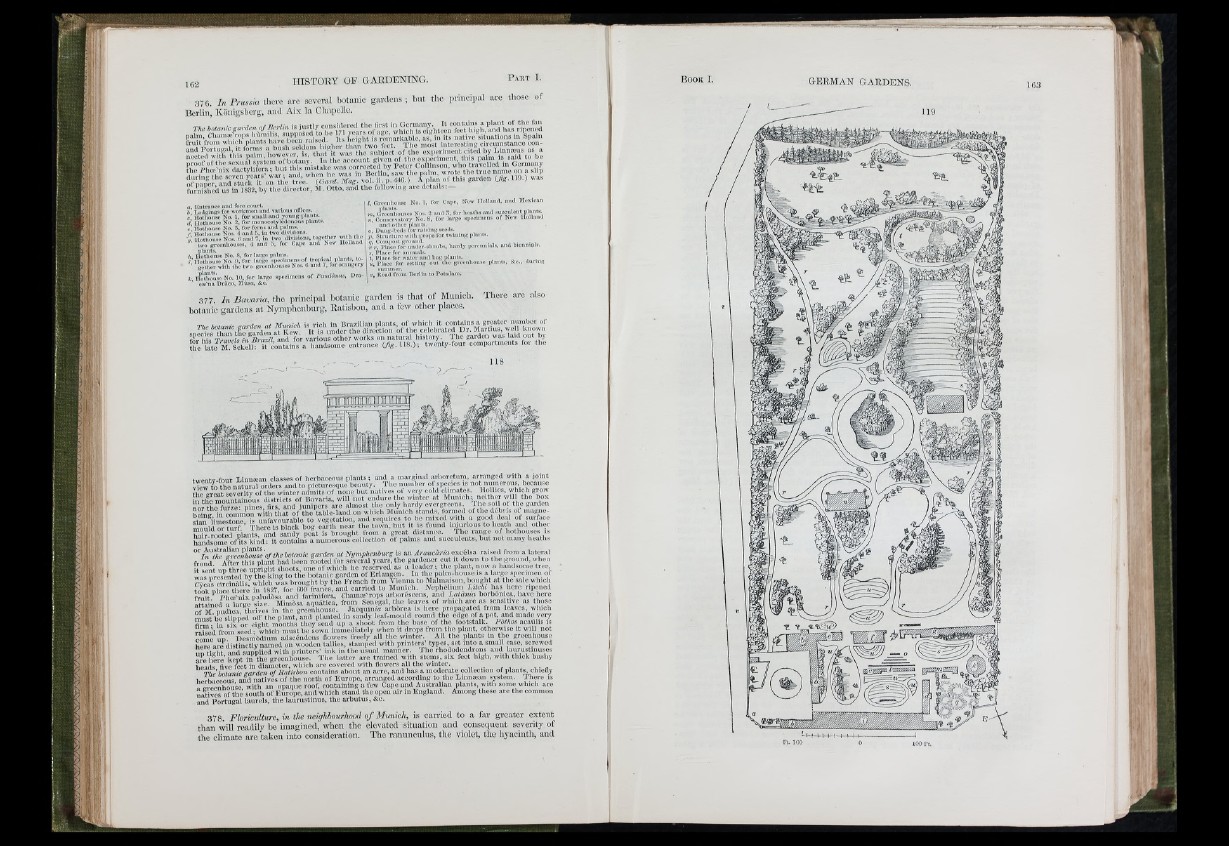
r . i i
370. In Prussia tlicrf are several liotaaic gardens ; bat the iirineipal arc tliose of
Berlin, Kon!g.sl)crg, and Ai-x la Cliaiielle.
S i i E P l l l i l l S i i
f u m S l us in 1832, tiy tlio director, M. Otto, ami the lollowing arc c le ta ils :-
■«, Kntrniico aiul foro court.
Lotlffiuita for wni'kmc'U unii varloti» olilcos.
c llotiiou»«' No. 1, for sinivll iiml youiig i>liiiiU'.
■I IIotliouHO No. 2, l'or mouocotyU'tloiiouH iiliiiits.
e lloUiott»«' No. ?>, tur fonie aiul luOina.
/•. Hotliouno Nos. •! ntiil r>. In two ilIvUlons.
; llotlionsoNo». Ü1UU17, in tw illvhions. togot lor «>t II. ■
' two grocnUouscs, 4 an.l 5, for CiRic itud New llollautl
h llotUoiisc No. 8, l'or lai'go jiftlins. i , , . .
i.’ lIolliouBo No. 0. for Inrgo Kpoolincns of troplcvl ^
gctlior w lth tlio twi) grocnluHiBCB Nos. 0 ami 7, lo r ornngory
k, liollì'ouso No. IO, for largo gpoclnicns o f ÌMìkìcIiìiw. Dra-
cio'iia DriVco, Mùsa, &c.
e following il
l. Grcouliouio No. 1, l'or Cape, Ntnv llollam l, an d Moxionn
Jm m h o u so a Nos. 2 ami 5, for Uoatlis and sueculont nlmitH.
CotiBorviitory No. 8, for largo spi olmoiiB of Now Iliilluml
ami otlii r idiviUs.
Dmig.l'od«/orraittlugHoocls,
7>, Strm-tm'o with prop# for twining plants.
rV ^ Í'ra c /ftí^ u u ío i^ s ln 'u h a rd y pori-iiulivlB, ami biennials.
*, Placo for ammiils.
f. Placo for water an d bog j.laiiiK. , , , ^1,«,
for sotting o u t tho greenhouse plañís, &c., ilnring
riiere arc also
377 In Bavaria, tlic pviiicipiil botmnc garden is that of Munich. The:
botanic gardens at Nymplienburg, Ratisbon, and a lew other pla.cc.s.
niants, of which it contains •• " " •....* ■aat -g.'Are:.a,»t er mnnkbncorw onf
t a d - t o
ihe tate a handsome entrance {Jig. 118.); twenty-four compartments lor the
ftvonte four Linnrcan classes of herbaceous plants; and a marginal arboretum, arranged with a joint
t n to f f n a t S n d orders and to picture.sque beauty. T h e number of species is not numerous, because
foe trrSttt s c / J r iK winter admits of none but natives of very cold dimntes. Ho lies, which grow
in t / i mountainmis districts of Bavaria, will not endure the wiftc r a t Munich; neither wil the box
n o r / l i f u i z e - nines, firs, and junipers are almost tlie only liardy evorgroens. 1 he soi ot tlie garden
hoin J in common w th that of tlio table-land on wliich Munich stands, lonnqd oi tlic hns oi inagme-
lH / ^ ’imc!tmm is mitivourablc to vegetation, and requires to be mixed witli a good deal of .surface
mould or tu rf ’ There is black bog earth near the town, b u t it is found injurious to heath and othqi
H r ro S ed Plants and sandy peat is brought from a great distance. Tim range ol Imthoqscs is
h S S m o o f l i r k in d : it contains a numerous collection of jialms ami succulents, bnt not many licutlis
Alt. . A A, .V , rge.fvlrJe-Atíríe-.)K G aa»t. NCryeimtrepAhnie InftbAultrrt!g f\lsl.
a yfmíícííj'/rtcxcélsa raised from a lateral
frond r'ootcd fo^ Vc^vcÎal y ^ gardener cut it down to the ground, when
Usmit un thrae upright slioots, one of whicli he reserved as a leader; tho niant, now a hamlsmnc tree,
wa/?.rësonted'î)V t h / ^ to the botanic garden of Erlangen. In tho palm-lunise is a large specimen qi
r ^ c a / S n - ' l i s which was brought by the French from Vienna to Malmaison, bought at the sale which
took nWra there h ' 1827. for C(K) frnims, and carried to Munich. Nophôluim LUc u ..as hore ripmie
f f tiV Phm-mxn.aludbsk and farinlfura,Chamæ'rops and atàma borbonica,her
;;h
meil
S ‘" P hoe -n i/ mlmÎô/iTimr'lkrïnVfura, Cham arborcsecns, ahd I.atània borbónica, have hero
attained H a ig e size. Mimósa aquritica, from Senegal, the leaves of whieh are as sensitive as those
of M pudica thrives in tlio grcenlmuse. .Tacquinm arbòrea is here propagated from leaves, whicli
muX'bi siufped off tlm plant, and planted in sandy leaf-mould round tlie cft'c of a pot, and mad., very
firm • in s x or eight months they send up a shoot from the base of the footstalk ncauiis is
S e d from seed ; which must be sown immediately when it drops from tho plant, otherwise it will not
/ S UP Desmòdium ndsccmlens flowers freely all the winter. All tho plants m th e greonl.ouse
S aie distinctly named on wooden tallies, stamped witli printers’ typos, set into a small case, screwed
U?. ? iS t and suppli..d with printers’ ink in the usual manner. The rhododendrons ami laurustiniisos
ara here S p t in the greenhouse. Tho latter arc trained with stems, six feet high, with thick biisliy
heads five leet in diameter, which are covered with flowers all the winter. re , a
r/re/.ft/flnm mrd cn of llntisbon contains about an acre, and lias a moderate collection of plants, chiefly
herbaceous, add natives of tlie north of Europe, arranged according to the Lmmraii system. 1 liore is
Jraonhouse with an op aq u e roof, containing a few Capo and Australian plants, witli some which are
natira s of the south of F.urope, and whicli stand tho oiieii air in England. Among these are the common
and Portugal laurels, the laurustinus, the arbutus, &c.
378. Floriculture, in the neighhourlwod o f Munich, is earned to a far [j,-cater extent
than will readily be imagined,' when the elevated situation and con.scquciit severity of
tlie climate arc taken into consideration. Tho ranunculus, the violet, the hyacinth, and
103